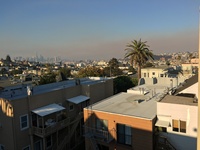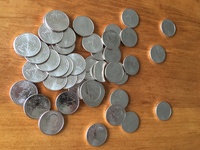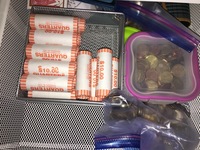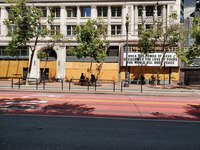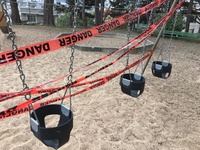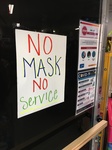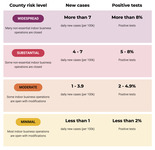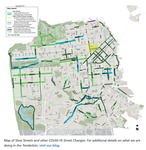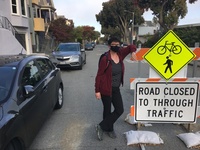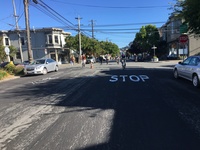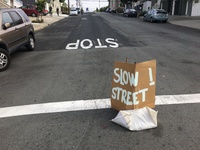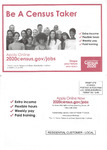 |
| Angelika/Mike Schilli |
|
|
Michael For about six months now, rent and real estate prices have been declining rapidly in San Francisco. Reason seems to be that there's a mass exodus happening, with young affluent people fleeing the city. On almost every block, you can see moving trucks, and techies sheepishly loading in their $3,000 bikes, and off they go to mommy and daddy in Kentucky! Just by walking the neighborhood, you can peer into many empty homes, and every block has at least one house for sale. Also, if you're in the market for expensive yuppie crap, check out Craigslist for some real bargains!
Since most tech companies no longer require their employees to come to the office, and also because San Francisco's entertainment value has gone down to almost zero, with most restaurants closed and dance clubs shuttered for a whopping six months now, hipsters no longer see a reason to stay around. On top of that, quality of life has been declining rapidly lately, with homeless tent cities popping up in various neighborhoods, many small shops throwing the towel and going out of business for good, I mean you can't even get simple services like a hair cut anymore! Property and street crime has gone up by 100% within the last year, due to the dramatic increase of the homeless population and lack of police activity due to a "progressive" district attorney who refuses to prosecute property crime even for repeat offenders. Who in their right mind would pay astronomical amounts of rent to live in such a neglected place?
Landlords are desparately trying to find new tenants for their properties, which is really hard, even with drastically reduced rent, because of complete lack of demand in the market with ample supply. Even in our building, there's three vacancies, all people in their twenties who have left the city to live someplace else. Oh, and those fools who have invested in real estate at astronomical prices are now facing financial hardships and cash flow problems, because mortgages still have to be paid off.
If this trend continues, the market will be flooded with cheap supply, and it's entirely possible that panic selling will start at some point if demand continues to decrease. Although, if you look at the current average home price in our expensive neighborhood, it's still around $2M, so there's still room for steep corrections until we get to a sustainable level again. Monitoring real estate brokers, you can sense their anxiety anticipating a crash, while they're reassuring their clients that price corrections will be only a few percentage points. I'd say: try 50 percent, every bubble is bound to burst at some point, and the San Francisco real estate bubble has been ripe for a while now. The market will fix even the most idiotic exhuberance at some point, that's one thing you can always rely on.
Angelika One night in mid August this year, we woke up to rolling thunder and intensly bright lightning. Thunderstorms are extremely rare in the San Franciso Bay Area, I can count the occations on the fingers of one hand since we moved here 20 years ago. Also, they don't happen in combination with rain, which is concerning in a region without any precipitation all summer long. Vegetation becomes bone dry only a few months into summer, and if lightning strikes, there's a high likelihood of a devastating wild fire to start. And indeed, a few days later, forest fires in many regions in California were all over the news.
Last Wednesday (9/9/2020) we woke up and thought we were on a different planet. Everything outside was cast in red-orange light, and no sun anywhere. It was so dark outside that we had to keep the indoor lights on the entire day. We lost track of the time of day. "Apocalyptic" is probaby the best way to describe the scenery. Meteorologists tried to calm down the population, and explained that the phenomenon occurs when smoke particles are floating upwards into higher regions of the atmosphere, breaking the sunlight before it reaches the surface, creating a red-orange tint, similar to what happens during a sunset. But, believe me, I've seen many sunset, and none of them looked even close to what happened here on Wednesday. Surprisingly, the air didn't smell smokey at all that day, apparently the particles were indeed high up there without floating down. However, I noticed that it was raining ashes from the sky, and when I got out on the balcony to take a few photos, I noticed some particles on my t-shirt. Now the news is that not only California is affected by the wildfires, but increasingly the States further north, Oregon and Washington.
So far, a total of 560 wild fires have been registered across California. Here in the city of San Francisco, we don't have any fires, luckily, but there are quite a few raging forest fires in the surrounding areas. The fires have been going on in Point Reyes, Santa Cruz, and in the Wine Country. Although large area wild fires have been a common occurrance in California for many years now, their impact is more severe under Covid conditions. Mass evacuations and fighting fires while practicing social distancing are new challenges. Also, this year, the fires came earlier than in the past, the usual fire season starts in October. We should have known it, nothing is like it was in 2020!
The surrounding fires impacted San Francisco's air quality severely for several weeks. Often, we woke up, looking at downtown through thick layer of haze, inhaling bad air that smelled like an extinguished camp fire, irrating our sinuses. Around four a clock in the afternoon, city air quality often got slightly better due to the the upcoming winds. Which is when we opened all doors and windows, which we had kept tighly closed until this point, to lock out hot air and smoky smells. To exactly hit the proper point in time, we ran hourly spot checks on our balcony, and also monitored airquality sites on the Internet, which constantly measured air quality and counted unhealthy floating particles, publishing the results for different cities and counties.
The categories are: good, moderate, unhealthy for sensitive groups (people with pre-existing conditions like asthma), unhealthy, very unhealthy, hazardous. We'll go out for a walk when we sense the air doesn't smell like a hundred full ash trays, or when the quality index is "moderate" or better. We always put on our Corona-defying cloth masks, but ironically they're utterly useless against the smoke particles. To filter these out, we'd need N95 masks, but those are better left to medical staff and shouldn't be bought off the market. A catch-22, no doubt. I found it interesting that it took the German news show Tagesschau, which we're watching religiously every day, a long time to start reporting on the fires in California. The general chaos of the year 2020 probably weighted heavier than our entire state affected by forest fires.
Michael Once a week is laundry day in our apartment, we're hauling several baskets full of dirty laundry down to the in-house laundromat and use the washers and dryers there. Each of them wants to be fed with quarter coins, and since one wash cycle costs $2.50, this requires ten coins each time. Each additional load adds more, and after the finishing spin cycle, the wet laundry needs to go in the dryer, which costs an additional $2.00 per load. In this way, it's not uncommon, that we spend 40 quarters per week, just for doing laundry.
No one carries that much small change in their wallets, of course, which is why we go to the bank every couple of months, bring a big shopping bag and carry home a kilo of these quarters. When I started doing the bank runs many years ago, I tried to be funny and asked the cashier if they could get me one of those cotton bags with an imprinted dollar signs for my loot, just like they do in cartoons, but this joke got old at some point. Recently, however, something rather surprising happened: The other day, the cashier told me that she could no longer provide me with $200 in quarters, as all banks were rationing them, and the maximum I could get was a single roll with $10 worth of quarters (40). What!?
The reason for this predicament was revealed recently in the news: Due to the economic slump caused by the Corona virus, customers have drastically reduced their visits to brick and mortar stores, and hence have stopped handing over their hard earned coins in exchange for desired goods, preventing the stores from returning these coins to the bank, which in turn caused a disruption of the natural flow of small change through the economy. I would have thought that hardly anyone around here pays cash anymore, let alone with small change, because most people use credit cards, but what do I know! The sad truth is that quarters are extremely hard to come by these days.
Some tentants already offered their landlords to buy back the quarters burried inside the machines. In our building, however, this isn't quite as straight forward, as the washers and dryers are being operated by a commercial service company. Laundromats in our neighborhood reportedly exchange dollar bills for quarters for their customers, but insist that the coins are being used on the premises and won't allow them to be carried home. If you're now thinking "Jeez, just set up washers with card readers!", then you have no idea about the amount of inertia working against any progress that involves large scale investments without immediate payoff in America.
In the end, it will most likely lead to shady businesses peddling quarters at inflated prices to desperated customers, similar to what happened during the international toilet paper crisis of 2020. Luckily, I had just been to the bank shortly before this mess started, and our quarter storage drawer is filled with several months of supplies. Hopefully, this will help us with our laundry needs until the quarter circulation problem has been fixed. Otherwise, we'll be skimping and stretch out the laundy schedule, washing our clothes only once every two weeks to save quarters should be feasible in a pinch.
Angelika As we're regular viewers of the German news show Tagesschau, every single day for more than a decade to be exact, we've recently become aware about how different countries are imposing very different types of restrictions on their citizens to battle the Corona crisis. We learned that apparently in Germany, there's nothing more important than traveling to your summer vacation destination. In comparison, I'd be quite happy already if at least my hair salon would be allowed to open again. It feels like we're stuck in a time capsule here in San Francisco. Mayor London Breed has put city life to a grinding halt since mid March, and there's been hardly any remediation since. I keep getting emails from the hair salon that they're going to open real soon now, but several dates have now been canceled, because Corona case numbers kept bouncing back. I've come to the conclusion that we'll have to wait until a vaccine is available, to see the city come back to life.
Since our last newsletter (Rundbrief 05/2020), there's been very little change, except that some stores which are offering their services outside, are allowed to open now. Restaurants are permitted to serve their customers at outside tables as well, also, the San Francisco Zoo and our Botanic Garden are again open to the public. Several gyms have moved their equipment onto the adjacent sidewalks, where members are allowed to work out. Unfortunately, outside business is hampered right now by the extremely bad air quality due to the recent wild fires in the area, which keeps desperately needed customers away, creating cash flow problems.
Also, summer camps with up to twelve children are permitted, and preschool classes with small groups have reopened in San Francisco. But all public schools in San Francisco remain closed! For retail business like clothing stores, there's strict mask and social distancing regulations, but they're open. The sad truth, however, is that many small and medium sized stores ran out of money and have been shuttered permanently. According to a survey conducted by the chamber of commerce, a whopping 54% of all stores went out of business! When I went to a dentist's appointment in July in downtown San Francisco (which has been permitted since June), the city was deserted, with many businesses looking rather bleak with boarded up window fronts.
What's confusing is that our governor Gavin Newsom lays out regulations for all of California, but individual cities and counties are permitted to have stricter rules. This results in wildly fluctuating restrictions even within a few miles, impacting daily life in different ways. At first, a so-called "watch list" determined what kind of restrictions individual counties in California had to enforce. If a county had the bad luck of landing on this watch list, certain stores had to close and various activities were shuttered.
To avoid ending up on this list, the county needs to have less than 100 cases per population of 100,000, averaged over 14 days. Also, the positive test rate must be lower than 8%. In addition, the hospitalization rate for Covid patients must be less than 10%, averaged over three days, and more than 20% of all IC units must be available. All Bay Area counties, including San Francisco, were on the list, but none managed to get off of it. The "watch list" reaped lots of criticism. And, totally out of the blue, governor Gavin Newsom announced at the end of August, that California had discontinued using the "watch list" in favor of a four color classification system (Figure 17 and California's Covid Information Page). It determines which businesses are allowed to open. Each county's color/class is determined by its infection rate and its positve test rate.
If county is in the yellow tier, meaning that there's less than one infected person per 100,000 residents, and also less than 2% of tests administered come back positive, practically all businesses are allowed to open. Counties in the (worst) purple tier, with more than seven infected of a population of 100,000, or a positive test rate of more than 8%, are in a dire place, because only absolutely essential businesses like grocery stores are allowed to open. Currently, San Francisco is in the red tier (4-7 infected per 100,000 and 2%-4.9% postitive test rate), and governor Gavin Newsom allowed hair salons to open with enhanced safety precaution protocols.
Also, California schools were allowed to open as well, but San Francisco mayor London Breed prefers a more careful approach. Hair salons in San Francisco are only allowed to cut hair outside in the open air. San Francisco schools are still closed. And the hair salon I go to doesn't want to offer their services on the sidewalk, so it's still Michael coloring and cutting my hair. In the meantime, he's gotten so good at it that we may be opening our own salon soon.
Michael Due to the lack of entertainment options during Corona, many residents in our neighborhood have, just like us, adopted the habit of daily extended walks through city streets. It is not easy to maintain social distancing etiquette on busy and narrow sidewalks, though, and the city came up with the new idea of declaring select streets as "slow" and allow pedestrians to use the road as well.
It didn't take long and the bureaucrats at SFMTA, San Francisco's Municipal Transportation Agency, responsible for street construction, maintenance and parking tickets, called out a city wide Slow Streets Program. At every intersection with other city streets, those slow streets then received big signs declaring "Road Closed To Through Traffic", indicating that only residents and their visitors could use them, but not drivers just crossing through.
However, the concept of virtually car-free streets was news to many locals here, and confused residents turned to the neighborhood forum app "Nextdoor" to inquire whether it was still okay to drive their own cars into their garages if they lived on one of the slow streets. Also, some stubborn sports car driving non-residents didn't seem to think the signs applied to them and drove through the slow sections anyway. In the Mission district, mainly home to immigrants from Mexico and Middle America, some signs mysteriously disappeared overnight, others were found kicked to the curb.
In the meantime, the new ordinance has reported a fairly high acceptance rate, although some slow street residents have voiced complaints about overzealous pedestrians yelling at them when they're driving up to their residences. Especially the more affluent neighborhoods have embraced the concept, and it's a joy to see families with small children, the latter riding around on city streets on their tiny bikes, which would be otherwise unthinkable in San Francisco. You can see adults jogging, riding skateboards and bicycles, using the entire width of the road. In less well off neighborhoods, like the Mission, as well as the less densely populated ones, like the Richmond or Sunset, the program is partially ignored, and as a pedestriant, you have to watch out or be run over by speeding cars.
Angelika It's hard to believe that yet another ten years have gone by, and it's time again for the US Census again. This one is our third time around (2000, 2010, 2020), but like everything today it was heavily influenced by Corona. Ten years ago, there was a questionaired mailed to individual households (Rundbrief 05/2010), which had to be completed. For those who did not comply, a friendly census employee came by in person, to knock on the door and help filling out the form. This time around, it was pretty evident, even before Corona hit, that the bureau had hoped to get people to answer the census questions online. It was the first time in history that this option even existed. And because of Corona, the bureau naturally aimed to reduce the number of census employees having to visit people in their homes.
The change from a paper-based survey to an online version naturally raised privacy concerns as well, because some of the data collected is quite sensitive. Experts feared security leaks and hacker attacks, so precautions had to be taken. What's the census for? The goal is to account for every resident, regardless of citizenship or even legal status.
Shortly before the census started, some agitation arose because Trump and Company demanded to include one question about each surveyed resident's citizenship status. This in turn raised some concerns about skewed data, because non-citizens might have feared potential repercussions and might have been less willing to fill out and submit the questionaire. In states like California or New York with a large number of illegal immigrants, it's traditionally been a challenge to get everyone to participate in the census. But it's important to collect the data accurately, because it determines how much federal money each state receives for initiatives, or how many representatives it can send to congress. After some back and forth, the question was dropped, while the census bureau kept pushing for finalizing the forms, updating the online software, and starting the survey. Historically, the surveys between the years 1890 and 1950 did include the citizenship question, by the way.
Now, how was the survey actually conducted this year? One day, we found a letter from the census bureau in our mailbox. It wasn't addressed to an individual or a family. It just specified our address, which makes sense once you know that in the U.S. there is no central register the government could use to find out who lives where. The letter simply stated "to resident at" with our address.
The cover letter explained the reasons behind the census, and pointed out that recipients are legally required to participate. If for any reason the online option didn't seem to work out, a paper version would be delivered within a few weeks. The letter then pointed to the website "my2020census.gov" in a large font within a giant frame. It also listed a personalized identification number to be entered on the website to start the survey. I had to answer the following questions for our household:
1. How many people were living or staying in this house, apartment, or mobile home on April 1, 2020?
2. Were there any additional people staying here on April 1, 2020, that you did not include in Question 1? (This refers to people living there temporarily).
3. Is this house, apartment, or mobile home owned by you or someone in this household with a mortgage or loan (including home equity loans)? Is it owned by you or someone in this household free and clear (without a mortgage or loan)? Rented? Occupied without payment of rent?
4. What is your telephone number?
5. What is Person 1's name?
6. What is Person 1's sex?
7. What is Person 1's age and what is Person 1's date of birth?
8. Is Person 1 of Hispanic, Latino, or Spanish origin?
9. What is Person 1's race? Options are: White; Black or African American; American Indian or Alaska Native; Chinese; Filipino; Asian Indian; Vietnamese; Korean; Japanese; other Asian; Native Hawaiian; Samoan; Chamorro; other Pacific Islander; some other race. Mark one or more boxes.
10. Print name of Person 2.
11. Does this person usually live or stay somewhere else?
12. How is this person related to Person 1?
13. What is Person 2's sex?
14. What is Person 2's age and what is Person 1's date of birth?
15. Is Person 2 of Hispanic, Latino, or Spanish origin?
16. What is Person 2's race?
And so on, depending how many people are living in the household. The question about a person's race is quite common in the U.S., although it might sound strange for German ears. If you were wondering about the differentiation between Spanish, Hispanic, and Latino above, the census form explains that for the purpose of the survey they determine a person's origin from Cuba, Mexica, Puerto Rica, South or Central America, or other Spanish culture, regardless of race.
It's also interesting that the survey asked for a person's full name. This is supposed to prevent duplicate counts. If someone didn't submit the form in a timely manner, the census bureau was quick to send out reminders. Recently, we had just returned home from a walk through the neighborhood, we saw a survey person at the door to our building, asking about parties in our building who hadn't filled out the questionaire yet. We of course had submitted ours online already.
Michael A few weeks ago, I woke up in the middle of the night to the infernal noise of revving muscle car engines and tires screeching over asphalt. No doubt, underoccupied juveniles, usually drag racing their cars and doing donuts on empty supermarket parking lots at night had discovered our idyllic neighborhood for their illegal activities.
And while it's pretty common in our area that soccer moms coasting through stop signs are pulled over mercilessly and slapped with $400 tickets, the police did not intervene with the donut drivers at all upon arrival. Neighbors had called 911, but when SFPD arrived, they only blocked off traffic at the affected intersections and let the smoking tires enthusiats do their thing. Police patiently waited out, until the crazies were done with their show, and then let them pass with impunity, when they drove home full throttle through series of red lights and stop signs.
This also illustrates nicely that San Francisco has now effectively established a two-class system: Laws apply to the wealthy, and the poor are encouraged to endulge in lawless activities without consequences. "Victimless crime" is the new District Attorney's spin on it, an individual named Chesa Boudin, voted into office by clueless idiots in an election with record low voter participation.
On paper, organized street racing is of course illegal, if caught and prosecuted, drivers would face fines, losing their license, or in severe cases even serve jail sentences. But San Francisco police has recentely established a new policy, and is no longer confronting these lawless drivers to avoid escalations. Instead, they divert traffic around those lawless events to avoid accidents. That's the bizarro world we've gotten used to living in, unfortunately.
In some jurisdictions, even watching a side show can be an illegal act. For example, last year, the city of San Jose (40 miles south of San Francisco) passed a bill to fine spectators during side shows up to $1000 or even put them in jail for six months! Well-situated citizens better head home once the tires start screeching!
Greetings from the most absurd city on earth:
Angelika und Michael







